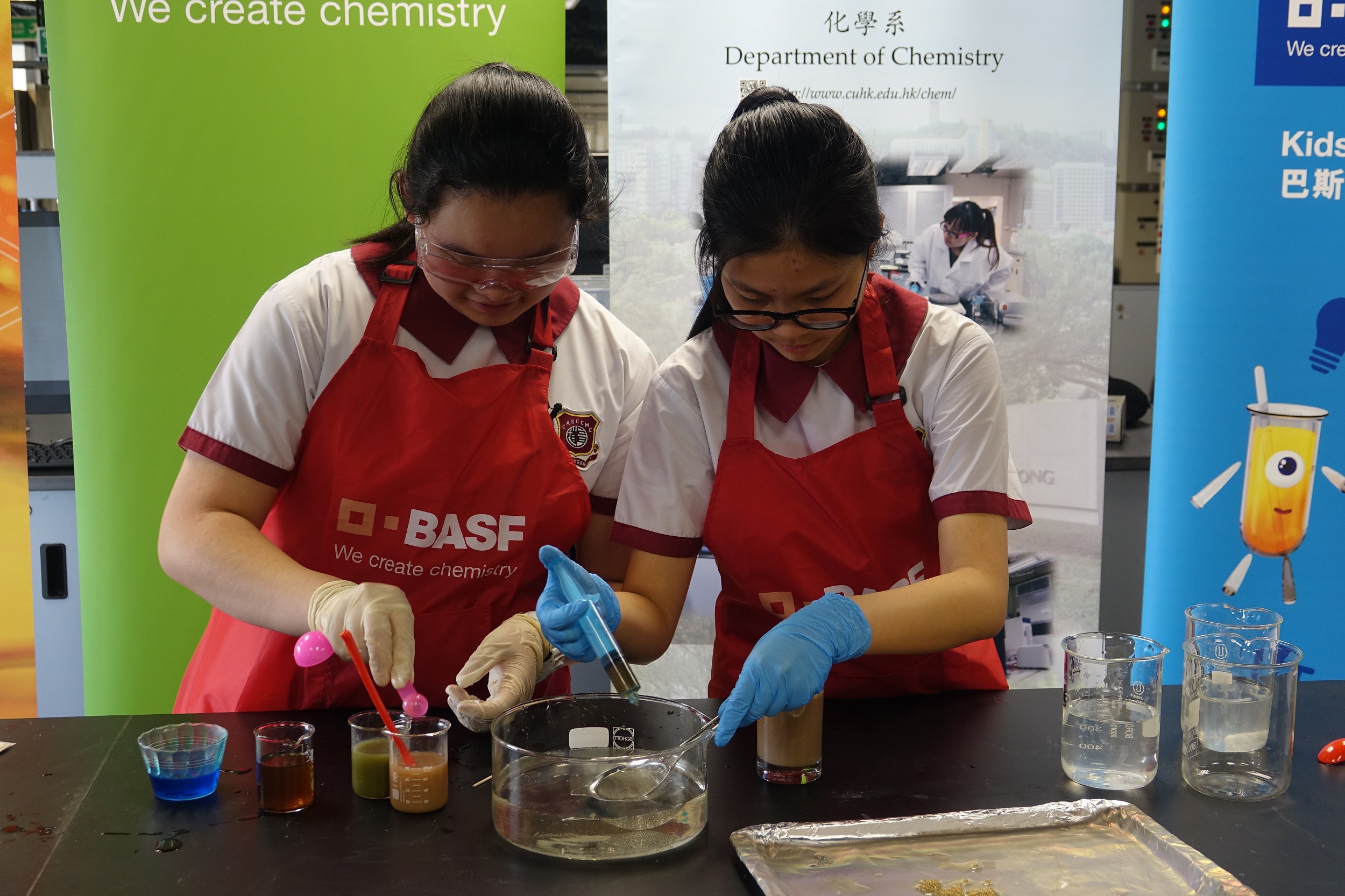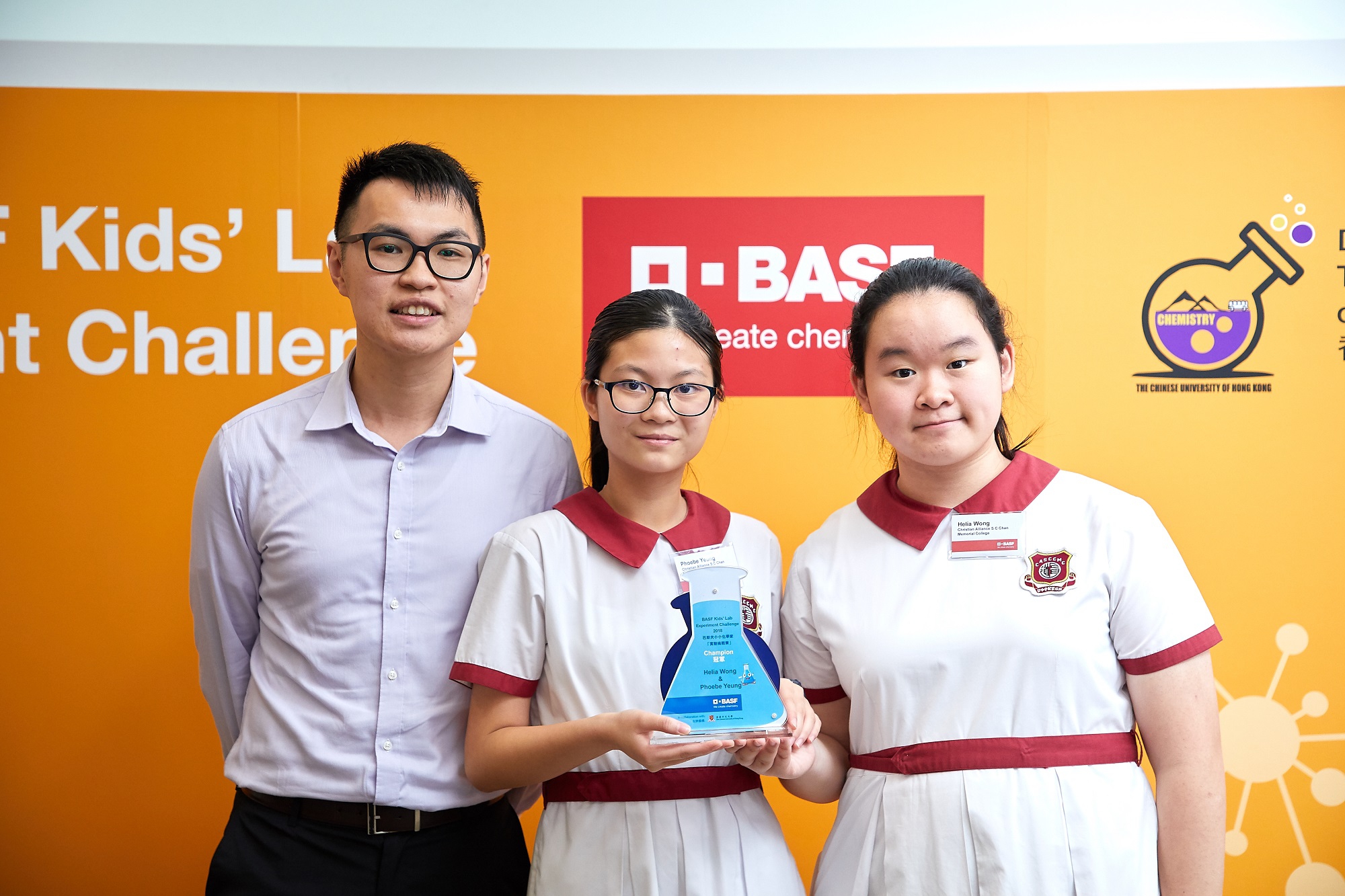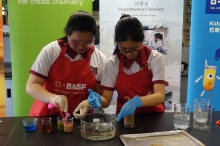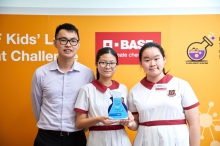CUHK
News Centre
Student scientists find inspiration from daily life to co-create fun chemistry experiments
Two Hong Kong secondary students have developed a brand new safe, hands-on experiment to help get young children interested in chemistry. Helia Wong and Phoebe Yeung, Form 5 students at Christian Alliance SC Chan Memorial College, are the winners of this year BASF Kids’ Lab Experiment Challenge, a program co-organized by BASF, the world’s leading chemical company, and The Chinese University of Hong Kong (CUHK).
With an aim to promote STEM (science, technology, engineering and math) education, the competition invites secondary school students to design an experiment for BASF’s Kids’ Lab, an interactive science workshop for 6 to 12-year-old children. The winning experiment will be used throughout Asia Pacific at BASF Kids’ Lab. This year, students were tasked to create an experiment focusing on the themes of urban living, smart energy or food.
More than 100 students from 22 secondary schools competed this year, and the top six teams were selected to present their ideas to the panel of judges from BASF and CUHK on November 10, 2018. The teams were assessed based on their entries’ creativity, learning, safety and the feasibility of implementing the experiment in Kids’ Lab, as well as teamwork and presentation skills.
The champion team used bubble milk tea to demonstrate their key chemistry concept: they showed the chemical process behind how liquids can be formed into spheres with the use of sodium alginate and calcium lactate. Through the direct spherification or reverse spherification process, bubble-like spheres can be created from a liquid like milk tea. The winning pair was not only able to demonstrate their critical thinking with clear elaborations, but also delivered excellent performance in the question and answer session, impressing the judges with their scientific investigation skills.
“The Experiment Challenge provides an opportunity to raise students’ interest in science and technology, strengthen their ability to apply knowledge, and improve their creativity and problem-solving skills. Through this activity, we hope to encourage more students to pursue studies in STEM-related subjects to foster the development of the innovation and technology industry in Hong Kong,” said Prof. To Ngai, Professor of the Department of Chemistry, CUHK.
“With the Kids’ Lab Experiment Challenge, we want to promote interest in chemistry and to show how fundamental scientific principles can be applied in the real world. By designing experiments for younger children, participants are encouraged to think outside the textbook and apply their knowledge in practice,” said Daisy Lam, Head of Marketing Communications, Corporate Affairs Asia Pacific, BASF.
The first runners-up were Ken Hilton and Austin Tan from HKUGA College. Their experiment, “Food Powered Boat”, demonstrated how different acids react with a base at different speeds, forming carbon dioxide (CO2) that can power a plastic bottle “boat” in water. The second runners-up were Elizabeth Law and Huey Lee from St. Paul’s Convent School. By adding sodium alginate into calcium alginate, their experiment, “Where’s My Water Bottle?”, showed how a plastic water bottle can be replaced by an edible water ball formed through spherification. The other three teams of finalists came from Steward Pooi Kei Secondary School, St. Mary’s Canossian College and St. Paul’s Convent School.
BASF Kids’ Lab is a free and interactive chemistry education program designed for kids aged 6 to 12, to discover the world of chemistry through hands- on experiments to help them understand how chemistry can be found everywhere in our daily lives. Since its launch in 1997, the program has been brought to more than 30 countries and regions around the globe. In Asia Pacific, more than 300,000 kids have participated since 2002. The program was first introduced in Hong Kong in 2005.
About BASF
At BASF, we create chemistry for a sustainable future. We combine economic success with environmental protection and social responsibility. The more than 115,000 employees in the BASF Group work on contributing to the success of our customers in nearly all sectors and almost every country in the world. Our portfolio is organized into four segments: Chemicals, Performance Products, Functional Materials & Solutions and Agricultural Solutions. BASF generated sales of more than €60 billion in 2017. BASF shares are traded on the stock exchanges in Frankfurt (BAS), London (BFA) and Zurich (BAS). Further information at www.basf.com.
About The Chinese University of Hong Kong
Founded in 1963, CUHK is a leading comprehensive research university with a global reputation. Located in the heart of Asia, CUHK has a vision and a mission to combine tradition with modernity, and to bring together China and the West. Under the University’s unique collegiate system, the programmes and activities offered by its nine colleges complement the formal curricula by delivering whole-person education and pastoral care. The University has eight faculties: Arts, Business Administration, Education, Engineering, Law, Medicine, Science, and Social Science. Together with the Graduate School, the University offers over 300 undergraduate and postgraduate programmes. All faculties are actively engaged in research in a wide range of disciplines, with an array of research institutes and research centres specialising in interdisciplinary research of the highest quality.
CUHK is recognised as the most innovative university in Hong Kong and is ranked 22nd in the Asia-Pacific region by the latest ‘Reuters: Asia Pacific’s Most Innovative Universities’ listing. The University currently has more than 900 granted patents in different jurisdictions worldwide. Some of these patents have been licensed to relevant industries that help bring these innovations to the market to benefit society. In academic year 2017-18, CUHK has received 185 granted patents and filed 327 patent applications for inventions developed in the areas of medical technology, biotechnology, information technology, telecommunications, and materials science.
Helia Wong (left) and Phoebe Yeung (right) show the chemical process behind how liquids can be formed into spheres with the use of sodium alginate and calcium lactate.







